HPLC Fingerprint Analysis with the Antioxidant and Cytotoxic Activities of Selected Lichens Combined with the Chemometric Calculations
Abstract
1. Introduction
2. Results and Discussion
2.1. HPLC Results
2.2. Chemometric Analysis
Principal Component Analysis
2.3. Antioxidant Activity
2.3.1. DPPH Test
2.3.2. FRAP Test
2.4. Total Phenolic Content
2.5. Cytotoxic Activity
2.6. Partial Least Squares
3. Materials and Methods
3.1. Plant Material
3.2. Preparation of Extracts
3.3. High Performance Liquid Chromatograpy (HPLC) Conditions and the Description of Standard (Usnic Acid)
3.4. Antioxidant Activity
3.4.1. DPPH Test
3.4.2. FRAP (Ferric Reducing Antioxidant Power)
3.5. Total Phenolic Content with Folin-Ciocalteu Reagent
3.6. Assessment of Cytotoxicity by Trypan Blue Staining
3.6.1. Cell Line
3.7. Chemometric Analysis
3.7.1. Data Analysis and Pretreatment Chromatographic Data
3.7.2. Principal Component Analysis (PCA)
3.7.3. Correlation Between Biological Activity and Chromatographic Fingerprint by PLS
4. Conclusions
Supplementary Materials
Author Contributions
Funding
Conflicts of Interest
References
- Kosanić, M.; Manojlović, N.; Janković, S.; Stanojković, T.; Ranković, B. Evernia prunastri and Pseudoevernia furfuraceae lichens and their major metabolites as antioxidant, antimicrobial and anticancer agents. Food Chem. Toxicol. 2013, 53, 112–118. [Google Scholar] [CrossRef] [PubMed]
- Pavlović, V.; Stojanović, I.; Jadranin, M.; Vajs, V.; Djordjević, I.; Smelcerović, A.; Stojanović, G. Effect of four lichen acids isolated from Hypogymnia physodes on viability of rat thymocytes. Food Chem. Toxicol. 2013, 51, 160–164. [Google Scholar] [CrossRef] [PubMed]
- Bates, S.T.; Cropsey, G.W.G.; Caporaso, G.; Knight, R.; Fierer, N. Bacterial communities associated with the lichen symbiosis. Appl. Environ. Microbiol. 2011, 77, 1309–1314. [Google Scholar] [CrossRef] [PubMed]
- Manojlović, N.; Ranković, B.; Kosanić, M.; Vasiljević, P.; Stanojković, T. Chemical composition of three Parmelia lichens and antioxidant, antimicrobial and cytotoxic activities of some their major metabolites. Phytomedicine 2012, 19, 1166–1172. [Google Scholar] [CrossRef]
- Ranković, B. Lichen Secondary Metabolites, Bioactive Properties and Pharmaceutical Potential; Springer: Cham, Switzerland; Heidelberg, Germany; New York, NY, USA; Dordrecht, The Netherlands; London, UK, 2014. [Google Scholar] [CrossRef]
- Barros Alves, G.M.; Sousa Maia, M.B.; Souza Franco, E.; Galvão, A.M.; Silva, T.G.; Gomes, R.M.; Martins, M.B.; Silva Falcão, E.P.; Castro, C.; Silva, N.H. Expectorant and antioxidant activities of purified fumarprotocetraric acid from Cladonia verticillaris lichen in mice. Pulm. Pharmacol. Ther. 2014, 27, 139–143. [Google Scholar] [CrossRef]
- Manojlović, N.T.; Vasiljević, P.J.; Marković, Z.S. Antimicrobial activity of extracts and various fractions of chloroform extract from the lichen Laurera benguelensis. J. Biol. Res. Thessalon. 2010, 13, 27–34. [Google Scholar]
- Manojlović, N.T.; Vasiljević, P.J.; Masković, P.Z.; Juskovic, M.; Bogdanovic-Dusanović, G. Chemical composition, antioxidant, and antimicrobial activities of lichen Umbilicaria cylindrica (L.) delise (Umbilicariaceae). Evid. Based Complementary Altern. Med. 2012, 2012, 8. [Google Scholar] [CrossRef]
- Behera, B.C.; Mahadik, N.; Morey, M. Antioxidative and cardiovascular-protective activities of metabolite usnic acid and psoromic acid produced by lichen species Usnea complanata under submerged fermentation. Pharm. Biol. 2012, 50, 968–979. [Google Scholar] [CrossRef]
- Manojlović, N.T.; Vasiljević, P.J.; Gritsanapan, W.; Supabphol, R.; Manojlović, I. Phytochemical and antioxidant studies of Laurera benguelensis growing in Thailand. Biol. Res. 2010, 43, 169–176. [Google Scholar] [CrossRef]
- Nguyen, T.T.; Yoon, S.; Yang, Y.; Lee, H.B.; Oh, S.; Jeong, M.H.; Kim, J.J.; Yee, S.T.; Crisan, F.; Moon, C.; et al. Lichen secondary metabolites in Flavocetraria cucullate exhibit anti-cancer effects on human cancer cells through the induction of apoptosis and suppression of tumorigenic potentials. PLoS ONE 2014, 9, e111575. [Google Scholar] [CrossRef]
- Millot, M.; Girardot, M.; Dutreix, L.; Mambu, L.; Imbert, C. Antifungal and anti-biofilm activities of acetone lichen extracts against Candida albicans. Molecules 2017, 22, 651. [Google Scholar] [CrossRef] [PubMed]
- Ristić, S.; Ranković, B.; Kosani, M.; Stanojković, T.; Stamenković, S.; Vasiljević, P.; Manojlovi, I.; Manojlović, N. Phytochemical study and antioxidant, antimicrobial and anticancer activities of Melanelia subaurifera and Melanelia fuliginosa lichens. J. Food Sci. Technol. 2016, 53, 2804–2816. [Google Scholar] [CrossRef] [PubMed]
- Atalay, F.; Halici, M.B.; Mavi, A.; Çakir, A.; Odabaşoğlu, F.; Kazaz, C.; Aslan, A.; Küfrevioğlu, Ő.İ. Antioxidant phenolics from Lobaria pulmonaria (L.) Hoffm. and Usnea longissima ach. lichen species. Turk. J. Chem. 2011, 35, 647–661. [Google Scholar]
- Lopes, T.I.; Coelho, R.; Yoshida, N.; Honda, N.K. Radical-scavenging activity of Orsellinates. Chem. Pharm. Bull. 2008, 56, 1551–1554. [Google Scholar] [CrossRef]
- Thadhani, V.M.; Choudhary, M.I.; Ali, S.; Omar, I.; Siddique, H.; Karunaratne, V. Antioxidant activity of some lichen metabolites. Nat. Prod. Res. 2011, 25, 1827–1837. [Google Scholar] [CrossRef] [PubMed]
- Luo, H.; Yamamoto, Y.; Liu, Y.; Jung, J.S.; Kahng, H.; Koh, Y.J.; Hur, J. The in vitro antioxidant properties of Chinese highland lichens. J. Microbiol. Biotechnol. 2010, 20, 1524–1528. [Google Scholar] [CrossRef]
- Marante, F.; Castellano, A.; Rosas, F.; Aguiar, J.; Barrera, J. Identification and quantitation of allelochemicals from the lichen Lethariella canariensis: Phytotoxicity and antioxidative activity. J. Chem. Ecol. 2003, 29, 2049–2071. [Google Scholar] [CrossRef]
- Lohézic-Le Dévéhat, F.; Tomasi, S.; Elix, J.A.; Bernard, A.; Rouaud, I.; Uriac, P.; Boustie, J. Stictic acid derivatives from the lichen Usnea articulate and their antioxidant activities. J. Nat. Prod. 2007, 70, 1218–1220. [Google Scholar] [CrossRef]
- Jayaprakasha, G.K.; Rao, L.J. Phenolic constituents from the lichen Parmotrema stuppeum (Nyl.) hale and their antioxidant activity. Z. Naturforsch. C J. Biosci. 2000, 55, 1018–1022. [Google Scholar] [CrossRef]
- Kosanić, M.; Ranković, B. Lichens as possible sources of antioxidants. Pak. J. Pharm. Sci. 2011, 24, 165–170. [Google Scholar]
- Kosanić, M.; Ranković, B.; Vukojević, J. Antioxidant properties of some lichen species. J. Food Sci. Technol. 2011, 48, 584–590. [Google Scholar] [CrossRef] [PubMed]
- Ranković, B.; Ranković, D.; Marić, D. Antioxidant and antimicrobial activity of some lichen species. Microbiologia 2010, 79, 812–818. [Google Scholar] [CrossRef]
- Fukuoka, F.; Nakanishi, M.; Shibata, S.; Nishikawa, Y.; Takeda, T.; Tanaka, M. Polysaccharides in lichens and fungi. II. Antitumor activities on Sarcoma-180 of the polysaccharide preparations from Gyrophora esculenta miyoshi, Cetraria islandica (L.) ach. var. orientalis asahina, and some other lichens. GANN 1968, 59, 421–432. [Google Scholar]
- Shibata, S.; Nishikawa, Y.; Tanaka, M.; Fukuoka, F.; Nakanishi, M. Antitumour activities of lichen polysaccharides. Z. Krebs. 1968, 71, 102–104. [Google Scholar] [CrossRef] [PubMed]
- Kupchan, S.M.; Kopperman, H.L. L-Usnic acid: Tumor inhibitor isolated from lichens. Experientia 1975, 3, 625. [Google Scholar] [CrossRef] [PubMed]
- Shrestha, G.; St. Clair, L.L. Lichens: A promising source of antibiotic and anticancer drugs. Phytochem. Rev. 2013, 12, 229–244. [Google Scholar] [CrossRef]
- Paz, G.A.; Raggioa, J.; Gómez-Serranillos, M.P.; Palomino, O.M.; González-Burgos, E.; Carretero, M.E.; Crespo, A. HPLC isolation of antioxidant constituents from Xanthoparmelia spp. J. Pharm. Biomed. Anal. 2010, 53, 165–171. [Google Scholar] [PubMed]
- Marković, Z.S.; Manojlović, N.T. Analytical characterization of lichexanthone in lichen: HPLC, UV spectroscopic, and DFT analysis of lichexanthone extracted from Laurera benguelensis (Mull. Arg.) zahlbr. Monatsh Chem. 2010, 141, 945–952. [Google Scholar] [CrossRef]
- Serafini, I.; Lombardi, L.; Reverberi, M.; Ciccola, A.; Calà, E.; Sciubba, F.; Guiso, M.; Postorino, P.; Acetoc, M.; Bianco, A. New advanced extraction and analytical methods applied to discrimination of different lichen species used for orcein dyed yarns: Preliminary results. Microchem. J. 2018, 138, 447–456. [Google Scholar] [CrossRef]
- Latkowska, E.; Bober, B.; Chrapusta, E.; Adamski, M.; Kaminski, A.; Bialczyk, J. Secondary metabolites of the lichen Hypogymnia physodes (L.) Nyl. and their presence in spruce (Picea abies (L.) H. Karst.) bark. Phytochemistry 2015, 118, 116–123. [Google Scholar] [CrossRef]
- Musharraf, S.G.; Siddiqi, F.; Ali, A.; Thadhanic, V.M. Sensitive analysis of bioactive secondary metabolites in lichen species using liquid chromatography–mass spectrometry. J. Pharm. Biomed. Anal. 2017, 146, 279–284. [Google Scholar] [CrossRef] [PubMed]
- Parrot, D.; Peresse, T.; Hitti, E.; Carrie, D.; Grubee, M.; Tomasia, S. Qualitative and spatial metabolite profiling of lichens by a LC–MS approach combined with optimised extraction. Phytochem. Anal. 2015, 26, 23–33. [Google Scholar] [CrossRef] [PubMed]
- Castro, O.N.; Benites, J.; Rodilla, J.; Santiago, J.C.; Simirgiotis, M.; Sepulveda, B.; Areche, C. Metabolomic analysis of the lichen Everniopsis trulla using ultra high performance liquid chromatography-quadrupole-orbitrap mass spectrometry (UHPLC-Q-OT-MS). Chromatographia 2017, 80, 967–973. [Google Scholar] [CrossRef]
- Straek, D.; Feige, G.B.; Kroll, R. Screening of aromatic secondary lichen substances by high performance liquid chromatography. Z. Naturforsch. 1979, 34c, 695–698. [Google Scholar] [CrossRef]
- Gupta, V.K.; Darokar, M.P.; Shanker, K.; Negi, A.S.; Srivastava, S.K.; Gupta, M.M.; Khanuja, S.P.S. Rapid and sensitive HPLC method for the determination of polyphenols in various lichen species of himalayan origin. J. Liq. Chromatogr. Relat. Technol. 2007, 30, 97–111. [Google Scholar] [CrossRef]
- Geyer, M.; Feuerer, T.; Feige, G.B. Chemie und systematik in der flechtengattung rhizocarpon: Hochdruckflüssigkeitschromatographie (HPLC) der flechten-sekundärstoffe der rhizocarpon superficiale-gruppe. Plant Syst. Evol. 1984, 145, 41–54. [Google Scholar] [CrossRef]
- Archer, A.W.; Elix, J.A. Additional new taxa and a new report of Pertusaria (lichenised ascomycotina) from Australia. Mycotaxon 1993, 49, 143–150. [Google Scholar]
- Bonny, S.; Paquin, L.; Carrié, D.; Boustie, J.; Tomasi, S. Ionic liquids based microwave-assisted extraction of lichen compounds with quantitative spectrophotodensitometry analysis. Anal. Chim. Acta. 2011, 707, 69–75. [Google Scholar] [CrossRef]
- Řezanka, T.; Dembitsky, V.M. Identification of acylated xanthone glycosides by liquid chromatography–atmospheric pressure chemical ionization mass spectrometry in positive and negative modes from the lichen Umbilicaria proboscidea. J. Chromatogr. A 2003, 995, 109–118. [Google Scholar]
- Roach, J.A.G.; Musser, S.M.; Morehouse, K.; Woo, J.Y.J. Determination of usnic acid in lichen toxic to elk by liquid chromatography with ultraviolet and tandem mass spectrometry detection. J. Agric. Food Chem. 2006, 54, 2484–2490. [Google Scholar] [CrossRef]
- Wu, Q.Y.; Zhou, Y.; Jin, X.; Guan, Y.; Xu, M.; Liu, L.F. Chromatographic fingerprint and the simultaneous determination of five bioactive components of Geranium carolinianum L. water extract by high performance liquid chromatography. Int. J. Mol. Sci. 2011, 12, 8740–8749. [Google Scholar] [CrossRef] [PubMed]
- Tang, D.; Yang, D.; Tang, A.; Gao, Y.; Jiang, X.; Mou, J.; Yin, X. Simultaneous chemical fingerprint and quantitative analysis of Ginkgo biloba extract by HPLC-DAD. Anal. Bioanal. Chem. 2010, 396, 3087–3095. [Google Scholar] [CrossRef] [PubMed]
- Le Pogam, P.; Le Lamer, A.C.; Joël Boustie, B.L.; Rondeau, D. In situ DART-MS as a versatile and rapid dereplication tool in lichenology: Chemical fingerprinting of Ophioparma ventosa. Phytochem. Anal. 2016, 27, 354–363. [Google Scholar] [CrossRef] [PubMed]
- Bansal, A.; Chhabra, V.; Rawal, R.K.; Sharman, S. Chemometrics: A new scenario in herbal drug standardization. J. Pharm. Anal. 2014, 4, 223–233. [Google Scholar] [CrossRef] [PubMed]
- Liang, Y.Z.; Xie, P.; Chan, K. Quality control of herbal medicines. J. Chromatogr. B 2004, 812, 53–70. [Google Scholar] [CrossRef]
- Van Nederkassel, A.M.; Daszykowski, M.; Massart, D.L.; Vander Heyden, Y. Prediction of total green tea antioxidant capacity from chromatograms by multivariate modeling. J. Chromatogr. A 2005, 1096, 177–186. [Google Scholar] [CrossRef]
- Liu, X.; Zhan, H.; Qiao, Z.; Zheng, M.; Liu, W.; Feng, F.; Yan, F. Chemometric analysis based on HPLC multi-wavelength fingerprints for prediction of antioxidant components in Turpiniae Folium. Chemom. Intell. Lab. Syst. 2016, 152, 54–61. [Google Scholar] [CrossRef]
- Hoai, N.N.; Dejaegher, B.; Tistaert, C.; Nguyen, V.; Hong, T.; Rivière, C.; Chataigné, G.; Van, K.P.; Van, M.C.; Quetin-Leclercq, J.; et al. Development of HPLC fingerprints for Mallotus species extracts and evaluation of the peaks responsible for their antioxidant activity. J. Pharm. Biomed. Anal. 2009, 50, 753–763. [Google Scholar] [CrossRef]
- Wold, S.; Sjostrom, M.; Eriksson, L. PLS-regression: A basic tool of chemometrics. Chemom. Intell. Lab. Syst. 2001, 58, 109–130. [Google Scholar] [CrossRef]
- Garthwaite, P. An interpretation of partial least-squares. J. Am. Stat. Assoc. 1994, 89, 122–127. [Google Scholar] [CrossRef]
- Dumarey, M.; Van Nederkassel, A.M.; Deconinck, E.; Vander Heyden, Y. Exploration of linear multivariable calibration techniques to predict the total antioxidant capacity of green tea from chromatographic fingerprint. J. Chromatogr. A 2008, 1192, 81–88. [Google Scholar] [CrossRef] [PubMed]
- Garza-Juárez, A.; Salazar-Cavazos, M.L.; Salazar-Aranda, R.; Pérez-Meseguer, J.; Waksman de Torres, N. Correlation between chromatographic fingerprint and antioxidant activity of Turnera diffusa (Damiana). Planta Med. 2011, 77, 958–963. [Google Scholar] [CrossRef] [PubMed]
- Anderson, T.; Wagner, D.; Cooper, B.; McCarty, M.; Zaspel, J. HPLC-MS analysis of lichen-derived metabolites in the life stages of Crambidia cephalica (grote & robinson). J. Chem. Ecol. 2017, 43, 66–74. [Google Scholar] [PubMed]
- Konoreva, L.; Prokopiev, I.; Frolov, I.; Chesnokov, S.; Rozhina, S.; Poryadina, L.; Shavarda, A. Metabolite profiling of the Cladonia lichens using gas chromatography-mass spectrometry. Biochem. Syst. Ecol. 2019, 85, 3–12. [Google Scholar] [CrossRef]
- Gadea, A.; Le Lamer, A.C.; Le Gall, S.; Jonard, C.; Ferron, S.; Catheline, D.; Ertz, D.; Le Pogam, P.; Boustie, J.; Le Devehat, F.L.; et al. Intrathalline metabolite profiles in the lichen Argopsis friesiana shape gastropod grazing patterns. J. Chem. Ecol. 2018, 44, 471–482. [Google Scholar] [CrossRef] [PubMed]
- Stojanović, G.; Stojanović, I.; Stankov-Jovanović, V.; Mitić, V.; Kostić, D. Reducing power and radical scavenging activity of four parmeliaceae species. Cent. Eur. J. Biol. 2010, 5, 808–813. [Google Scholar] [CrossRef]
- Bézivin, C.; Tomasi, S.; Rouaud, I.; Delcros, J.G.; Boustie, J. Cytotoxic activity of compounds from the lichen: Cladonia convoluta. Planta Med. 2004, 70, 874–877. [Google Scholar] [CrossRef] [PubMed]
- Einarsdóttir, E.; Groeneweg, J.; Björnsdóttir, G.G.; Harðardottir, G.; Omarsdóttir, S.; Ingólfsdóttir, K. Cellular mechanisms of the anticancer effects of the lichen compound usnic acid. Planta Med. 2010, 76, 969–974. [Google Scholar] [CrossRef] [PubMed]
- Basile, A.; Rigano, D.; Loppi, S.; Di, S.A.; Nebbioso, A.; Sorbo, S.; Conte, B.; Paoli, L.; De Ruberto, F.; Molinari, A.M.; et al. Antiproliferative, antibacterial and antifungal activity of the lichen Xanthoria parietina and its secondary metabolite parietin. Int. J. Mol. Sci. 2015, 16, 7861–7875. [Google Scholar] [CrossRef]
- Ari, F.; Celikler, S.; Oran, S.; Balikci, N.; Ozturk, S.; Ozel, M.Z.; Ozyurt, D.; Ulukaya, E. Genotoxic, cytotoxic, and apoptotic effects of Hypogymnia physodes (L.) Nyl. on breast cancer cells. Environ. Toxicol. 2014, 29, 804–813. [Google Scholar] [CrossRef]
- Maisuthisakul, P.; Pasuk, S.; Ritthiruangdej, P. Relationship between antioxidant properties and chemical composition of some Thai plants. J. Food Compos. Anal. 2008, 21, 229–240. [Google Scholar] [CrossRef]
- Ulewicz-Magulska, B.; Wesolowski, M. Total phenolic contents and antioxidant potential of herbs used for medical and culinary purposes. Plant Foods Hum. Nutr. 2019, 74, 61–67. [Google Scholar] [CrossRef] [PubMed]
- Javanmardi, J.; Stushnoff, C.; Locke, E.; Vivanco, J.M. Antioxidant activity and total phenolic content of Iranian Ocimum accessions. Food Chem. 2003, 83, 547–550. [Google Scholar] [CrossRef]
- Spiridon, I.; Bodirlau, R.; Teaca, C. Total phenolic content and antioxidant activity of plants used in traditional Romanian herbal medicine. Cent. Eur. J. Biol. 2011, 6, 388–396. [Google Scholar] [CrossRef]
- Gonçalves, S.; Gomes, D.; Costa, P.; Romano, A. The phenolic content and antioxidant activity of infusions from Mediterranean medicinal plants. Ind. Crop. Prod. 2013, 43, 465–471. [Google Scholar] [CrossRef]
- Brand-Williams, W.; Cuvelier, C.; Berset, C. Use for a free radical method to evaluate antioxidant activity. LWT Food Sci. Technol. 1995, 28, 25–30. [Google Scholar] [CrossRef]
- Śnieżek, E.; Szumska, M.; Janoszka, B. Evaluation of antioxidant properties of selected plant products in terms of the possibility of their use as additions to heat-treated high-protein food. Food Sci. Technol. Qual. 2016, 5, 116–126. (In Polish) [Google Scholar]
- Folin, O.; Ciocalteu, V. On tyrosine and tryptophane determinations in proteins. J. Biol. Chem. 1927, 73, 627–650. [Google Scholar]
- Singleton, V.L.; Rossi, J.A. Colorimetry of total phenolics with phosphomolybdic-phosphotungstic acid reagents. Am. J. Enol. Vitic. 1965, 16, 144–158. [Google Scholar]
- Wong, J.; Durante, C.; Cartwright, H. Application of fast Fourier transform cross-correlation for the alignment of large chromatographic and spectral datasets. Anal. Chem. 2005, 77, 5655–5661. [Google Scholar] [CrossRef]
- Kim, S.; Kim, K.Y.; Han, C.S.; Ki, K.S.; Min, K.J.; Zhang, X.; Whang, W.K. Simultaneous analysis of six major compounds in Osterici radix and Notopterygii rhizoma et radix by HPLC and discrimination of their origins from chemical fingerprint analysis. Arch. Pharm. Res. 2012, 35, 691–699. [Google Scholar] [CrossRef] [PubMed]
- Mazina, J.; Vaher, M.; Kuhtinskaja, M.; Poryvkina, L.; Kaljurand, M. Fluorescence, electrophoretic and chromatographic fingerprints of herbal medicines and their comparative chemometric analysis. Talanta 2015, 139, 233–246. [Google Scholar] [CrossRef] [PubMed]
Sample Availability: Samples of the compounds are not available from the authors. |
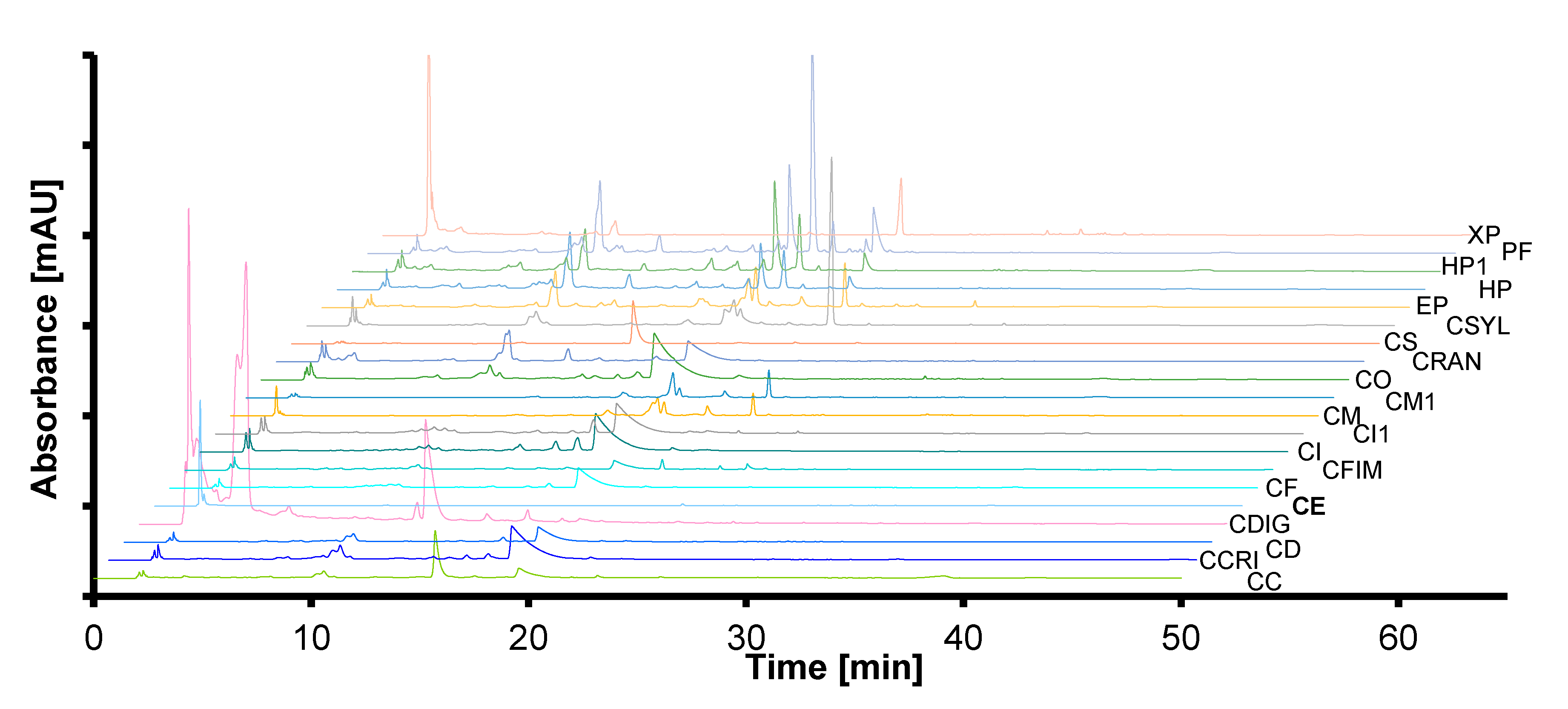
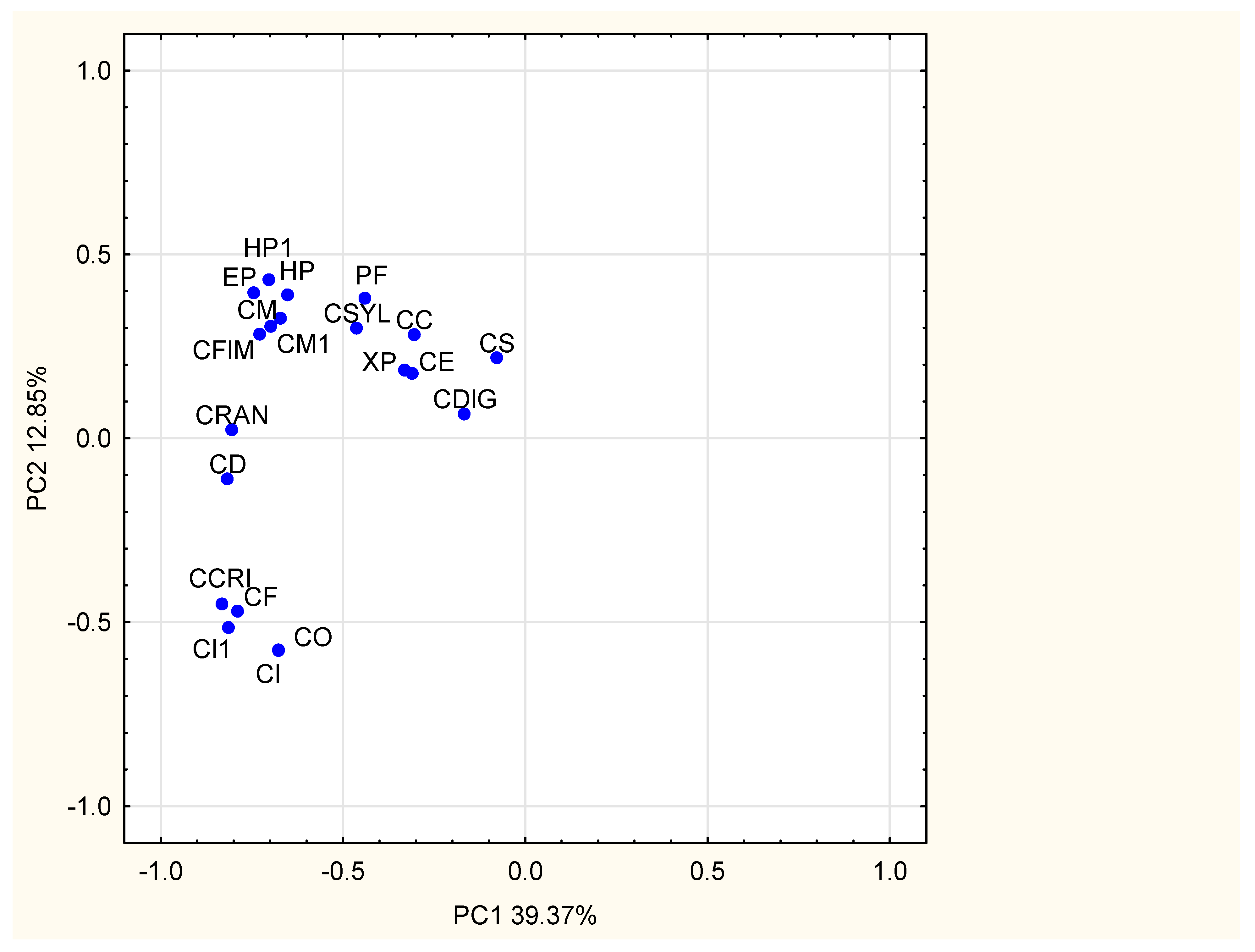
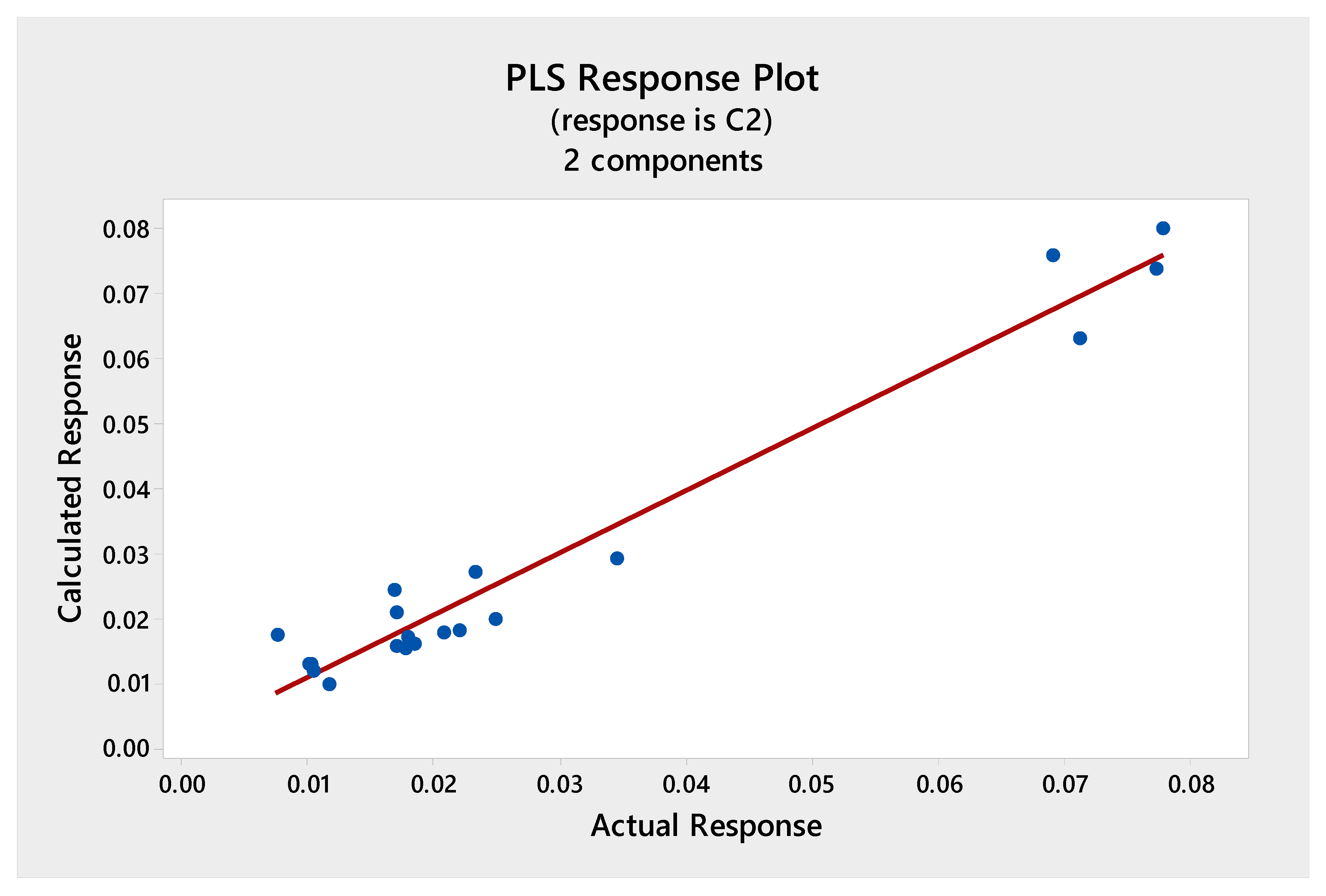
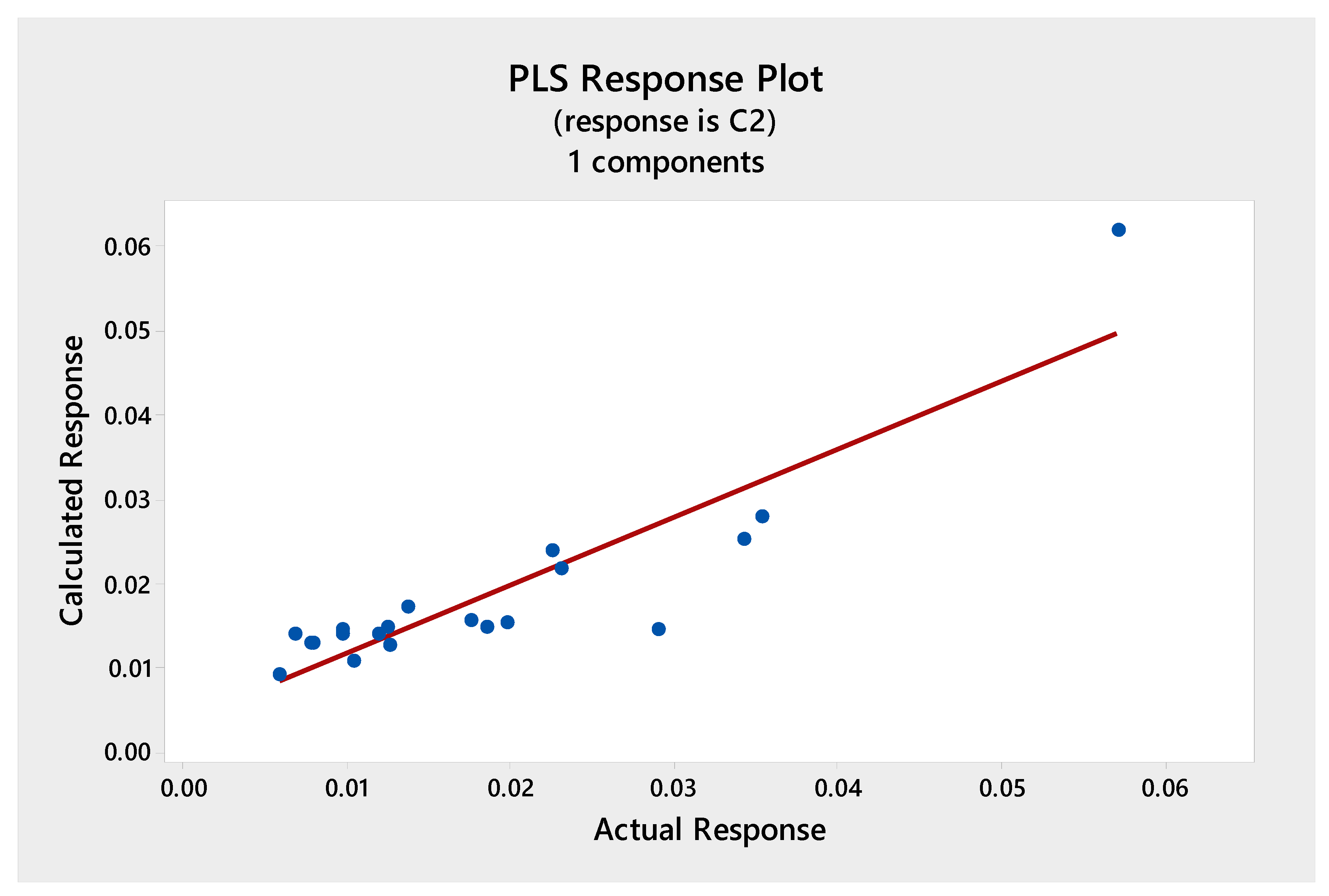
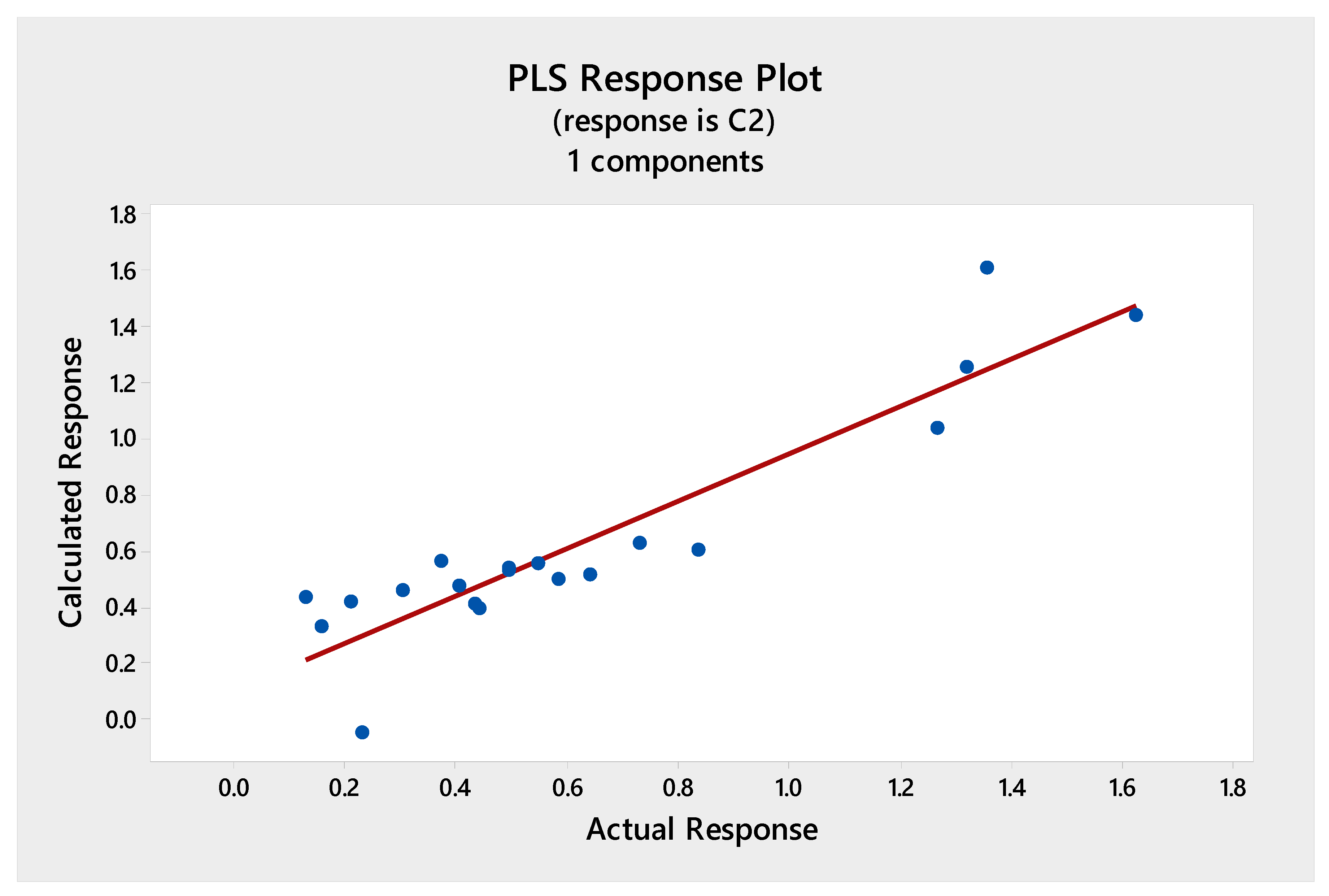
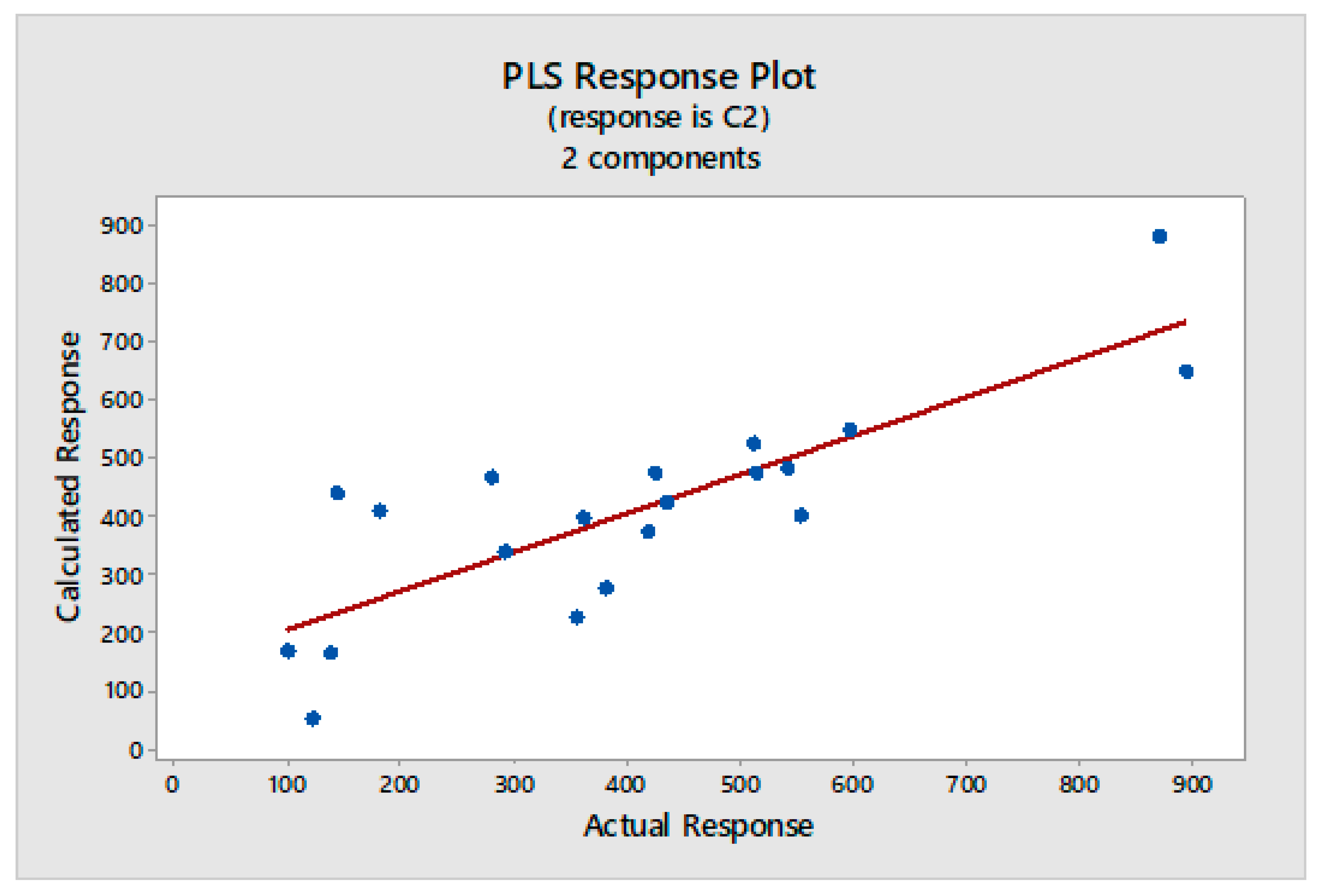
| No. | Name | Symbol | Time of Harvest |
|---|---|---|---|
| 1. | Hypogymnia physodes (L.) Nyl. | HP | X. 2016 |
| 2. | HP1 | IX. 2016 | |
| 3. | Evernia prunastri (L.) Ach. | EP | X. 2016 |
| 4. | Pseudevernia furfuracea (L.) Zopf | PF | XI. 2016 |
| 5. | * Cetaria ericetorum Opiz | CE | XI. 2016 |
| 6. | * Cetraria islandica (L.) Ach. | CI | XI. 2016 |
| 7. | CI1 | XI. 2016 | |
| 8. | * Cladina rangiferina (L.) Weber ex Wigg. synonym Cladonia rangiferina (L.) Nyl. | CRAN | V. 2017 |
| 9. | * Cladina arbuscula (Wallr.) Flotow synonym Cladonia sylvatica auct | CSYL | V. 2017 |
| 10. | Cladina mitis Sandst. Synonym C. mitis (Sandst.) Hustich (1951), C. arbuscula subsp. mitis (Sandst.) Ruoss (1987) | CM | X. 2016 |
| 11. | CM1 | XI. 2016 | |
| 12. | Cladonia digitata (L.) Hoffm. | CDIG | IV 2017 |
| 13. | Cladonia fimbriata (L.) Fr. synonym C. major (Hagen) Sandst., C. minor (Hagen) Vainio | CFIM | XI. 2016 |
| 14. | Cladonia ochrochlora Flk. | CO | IV. 2017 |
| 15. | Cladonia subulata (L.) Weber ex Wigg. synonym C. cornutoradiata (Coem.) Zopf. | CS | XI. 2016 |
| 16. | Cladonia cornuta (L.) Hoffm. | CC | XI. 2016 |
| 17. | Cladonia furcata (Huds.) Schrader | CF | X. 2016 |
| 18. | Cladonia crispata (Delise) Vainio | CCRI | V. 2017 |
| 19. | Cladonia phyllophora Hoffm. synonym C. degenerans (Flk.) | CD | XI. 2016 |
| 20. | Xanthoria parietina (L.) Th. Fr. | XP | IV. 2017 |
| DPPH | FRAP | F-C Test | ||
|---|---|---|---|---|
| Sample | Inhibition [%] | CTE [mg∙mL−1] (trolox) | CTE [mg∙mL−1] (trolox) | CGAE [mg∙mL−1] (gallic acid) |
| EP | 19.08 | 0.0185 ± 0.002 | 0.0119 ± 0.001 | 0.496 ± 0.061 |
| PF | 77.08 | 0.0690 ± 0.000 | 0.0225 ± 0.002 | 1.623 ± 0.067 |
| CE | 26.01 | 0.0221 ± 0.001 | 0.0127 ± 0.001 | 0.230 ± 0.018 |
| CS * | 24.57 | 0.0105 ± 0.001 | 0.00975 ± 0.001 | 0.211 ± 0.012 |
| CC | 17.10 | 0.0168 ± 0.003 | 0.0138 ± 0.001 | 0.3720 ± 0.093 |
| CFIM | 21.57 | 0.0180 ± 0.002 | 0.0176 ± 0.001 | 0.405 ± 0.008 |
| CSYL | 18.84 | 0.0177 ± 0.003 | 0.0059 ± 0.001 | 0.444 ± 0.060 |
| CDIG | 86.72 | 0.0771 ± 0.000 | 0.0571 ± 0.001 | 1.355 ± 0.093 |
| CCRI | 22.27 | 0.0207 ± 0.001 | 0.0104 ± 0.001 | 0.586 ± 0.021 |
| CRAN | 17.99 | 0.0170 ± 0.003 | 0.0125 ± 0.001 | 0.547 ± 0.013 |
| XP * | 24.85 | 0.0233 ± 0.002 | 0.0231 ± 0.001 | 0.4338 ± 0.046 |
| CO | 38.04 | 0.0344 ± 0.001 | 0.0198 ± 0.002 | 0.730 ± 0.091 |
| CI | 29.16 | 0.0249 ± 0.000 | 0.0185 ± 0.001 | 0.835 ± 0.143 |
| CI1 | 12.86 | 0.0102 ± 0.001 | 0.0290 ± 0.000 | 0.640 ± 0.022 |
| CM | 12.03 | 0.0117 ± 0.002 | 0.0078 ± 0.001 | 0.159 ± 0.018 |
| CM1 | 18.02 | 0.0170 ± 0.002 | 0.0068 ± 0.001 | 0.131 ± 0.022 |
| CD | 12.90 | 0.0103 ± 0.002 | 0.0080 ± 0.001 | 0.305 ± 0.055 |
| CF | 10.02 | 0.0076 ± 0.001 | 0.0098 ± 0.001 | 0.494 ± 0.047 |
| HP | 80.31 | 0.0711 ± 0.001 | 0.0342 ± 0.001 | 1.264 ± 0.019 |
| HP1 | 87.29 | 0.0778 ± 0.000 | 0.0353 ± 0.001 | 1.317 ± 0.013 |
| Sample | IC50 [µg∙mL−1] | Sample | IC50 [µg∙mL−1] |
|---|---|---|---|
| EP | 355.3 | XP | 553.3 |
| PF | 381.5 | CO | 511.3 |
| CE | 433.6 | CI | 514.0 |
| CS | 142.6 | CI1 | 541.8 |
| CC | 894.3 | CM | 418.4 |
| CFIM | 870.2 | CM1 | 180.2 |
| CSYL | 361.6 | CD | 596.6 |
| CDIG | 122.6 | CF | 279.1 |
| CCRI | 425.4 | HP | 136.5 |
| CRAN | 292.5 | HP1 | 99.4 |
| Symbol | Sample Weight [g] | Dry Residue [g] |
|---|---|---|
| EP | 9.9998 | 0.8276 |
| PF | 10.0421 | 2.0540 |
| CE | 9.9847 | 0.6504 |
| CS | 3.9996 | 0.1935 |
| CC | 10.0835 | 1.1382 |
| CFIM | 10.0274 | 0.9896 |
| CG | 10.0026 | 0.0668 |
| CSYL | 10.0300 | 1.0000 |
| CDIG | 10.0300 | 1.4500 |
| CRAN | 10.1800 | 0.7200 |
| XP | 7.9800 | 1.3300 |
| CO | 10.0400 | 2.8900 |
| CI | 10.2897 | 1.1090 |
| CI1 | 10.0303 | 1.1533 |
| CM | 10.0026 | 0.4339 |
| CM1 | 10.0151 | 0.3604 |
| CD | 10.0742 | 0.7670 |
| CF | 10.0035 | 0.6663 |
| HP | 10.0091 | 0.7498 |
| HP1 | 10.0569 | 0.5860 |
© 2020 by the authors. Licensee MDPI, Basel, Switzerland. This article is an open access article distributed under the terms and conditions of the Creative Commons Attribution (CC BY) license (http://creativecommons.org/licenses/by/4.0/).
Share and Cite
Hawrył, A.; Hawrył, M.; Hajnos-Stolarz, A.; Abramek, J.; Bogucka-Kocka, A.; Komsta, Ł. HPLC Fingerprint Analysis with the Antioxidant and Cytotoxic Activities of Selected Lichens Combined with the Chemometric Calculations. Molecules 2020, 25, 4301. https://doi.org/10.3390/molecules25184301
Hawrył A, Hawrył M, Hajnos-Stolarz A, Abramek J, Bogucka-Kocka A, Komsta Ł. HPLC Fingerprint Analysis with the Antioxidant and Cytotoxic Activities of Selected Lichens Combined with the Chemometric Calculations. Molecules. 2020; 25(18):4301. https://doi.org/10.3390/molecules25184301
Chicago/Turabian StyleHawrył, Anna, Mirosław Hawrył, Agnieszka Hajnos-Stolarz, Jagoda Abramek, Anna Bogucka-Kocka, and Łukasz Komsta. 2020. "HPLC Fingerprint Analysis with the Antioxidant and Cytotoxic Activities of Selected Lichens Combined with the Chemometric Calculations" Molecules 25, no. 18: 4301. https://doi.org/10.3390/molecules25184301
APA StyleHawrył, A., Hawrył, M., Hajnos-Stolarz, A., Abramek, J., Bogucka-Kocka, A., & Komsta, Ł. (2020). HPLC Fingerprint Analysis with the Antioxidant and Cytotoxic Activities of Selected Lichens Combined with the Chemometric Calculations. Molecules, 25(18), 4301. https://doi.org/10.3390/molecules25184301








